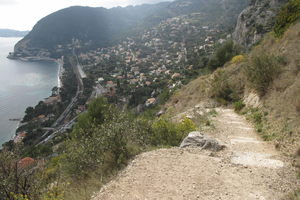Nietzsche’s Path in Èze, France

After losing year-long friendships with composer Richard Wagner and philosopher Arthur Schopenhauer over intellectual quarrels around the mid-1870s, the mental and emotional health of German philosopher Friedrich Nietzsche started to deteriorate.
In search of a cure for his ails and his ever-increasing migraines, Nietzsche started to roam the warmer climates of Northern Italy and Southern France, living as a free philosopher and eventually coming to some of his more radical philosophical ideas.
From December 1883 to April 1884, Nietzsche settled in the quiet coastal town of Èze, at the heart of the French Riviera. Èze is in fact made up of two conjoined villages. The modern town of Èze bord-de-Mer lies directly on the coast of the French Cote d’Azur. Several hundred meters up a steep mountain hill lies its neighbor, Èze Village, a dreamy medieval town with narrow winding streets.
The surroundings seemed to boast Nietzsche’s health, as he later recalled: “I slept well, I laughed a lot, and I found a marvellous vigour and patience”.
The natural surroundings of Èze also left a mark on Nietzsche’s philosophical writings. Hiking up and down a steep mountain trail, connecting the seaside to the medieval village, Nietzsche found the inspiration for the third part of his philosophical novel, Thus Spoke Zarathustra.
The route, which has since been named “Le Chemin de Nietzsche” by locals, naturally invites contemplation as it combines beautiful seaside views, green forest trails, and stunning mountain vistas.





